Town council websites to look at when you’re nostalgic for old-school internet

By Christalle Tay and Daryl Choo
SINGAPORE — Trying to navigate some town council websites is like stumbling upon an old blog you made in the 2000’s — wacky font sizes, wonky animations and thumbnails you won't know are hyperlinks until you actually click them.
Checks by GEMonitor found broken links, outdated schedules, missing annual reports from earlier years, and a general plague of erratic interface designs. Four of the 16 town councils did not even have websites that were optimised for mobile (the horror!).
For many first-time voters, estate management and activities hosted by their local town councils are their first glimpses into the world of municipal politics. And likely, this group of largely digital natives would turn to their town council’s website to learn their incumbent’s plans for the constituency.
If town councils were indeed attempting to evoke a nostalgia-filled aesthetic, then that strategy may very well have backfired.
To be sure, essential information such as the rates for booking facilities and monthly HDB estate upkeep charges, or residential service and conservancy charges (S&CC), were fairly easy to find for all the sites. Perfect for finding what you need and exiting as fast as possible.
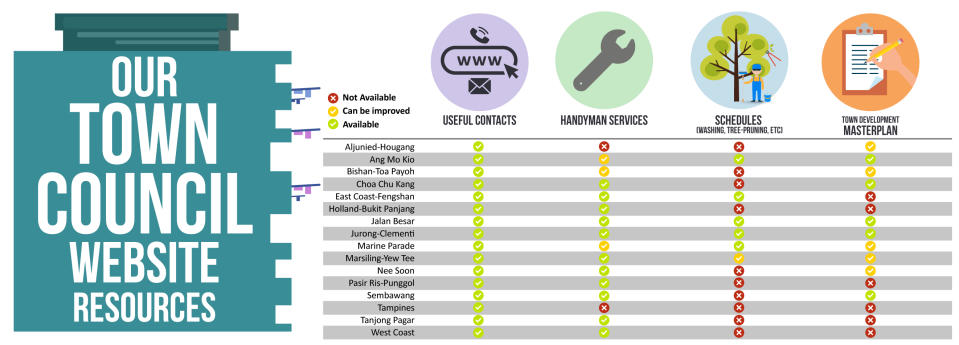
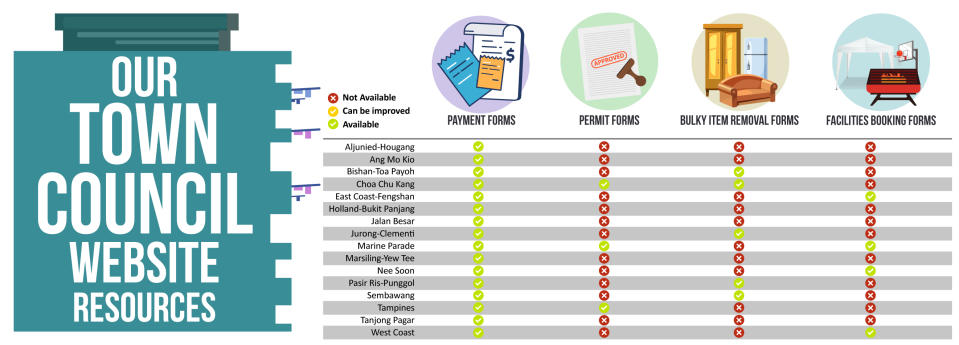
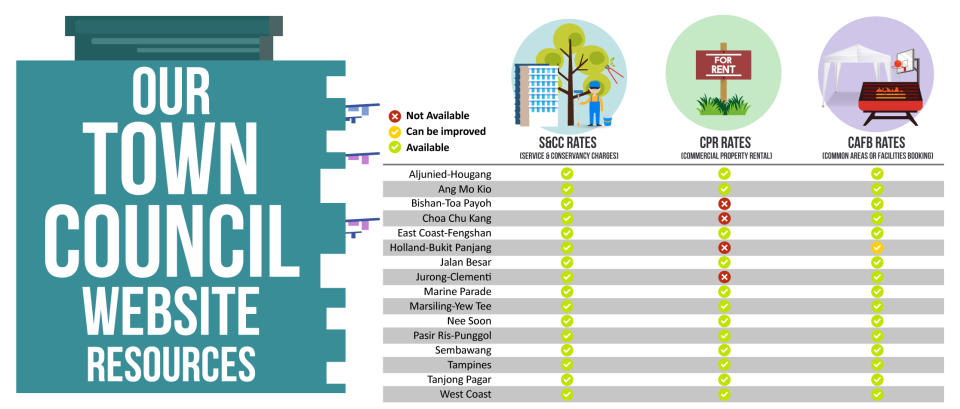
Town Councils are responsible for the day-to-day operations in managing the common property of HDB residential flats and commercial property within the town. If the corridor light is flickering, if you need to book the void deck, or even if your tap water tastes suspicious — you turn to the council.
The councillors are also the people you turn to if you want to rent commercial lots, such as for wet market stalls. Rent prices for these lots, however, were found on all but four of the town council websites. Those seeking to rent a stall in these four constituencies — Bishan-Toa Payoh, Chua Chu Kang, Holland-Bukit Panjang and Jurong-Clementi — will have to contact their town councils directly.
Searching for detailed development plans of each town also proved to be a challenge. West Coast Town Council, for example, did not publish on its website a long-term masterplan, choosing instead to occasionally outline upcoming improvement projects in its newsletter.
Under new policies set by the Ministry of National Development aimed at promoting greater transparency and management standards, town councils must abide by a refreshed code of governance from April next year which include disclosing its long-term plans for the town. The code, however, does not require town councils to make this information available on their websites.
The differences between the town councils’ websites were strikingly apparent when comparing how useful their sites were for the average resident.
Only four town councils — East Coast-Fengshan, Marine Parade, Nee Soon, and West Coast — allowed facilities like the void deck and barbeque pits to be booked directly to the website. Application for the removal of bulky items was similarly only available on the websites of four town councils.
Tanjong Pagar and Holland-Bukit Panjang’s website only showed the financial report for the latest year. Reports for previous years could only be accessed from the site by searching for them on Google.
For an organisation whose primary purpose is the management and maintenance of town councils, it was curious that schedules of upcoming routine works were missing from most websites — information that would be useful for residents who might be inconvenienced by these works.
Only a few town councils, such as Marine Parade, kept a schedule of upcoming repair and redecoration works, as well as dates for the washing of food centres and markets. Even for Ang Mo Kio, which was the only town council that kept a “schedule” for tree prunings, the exact dates these works will begin was not specified.
And for Marsiling-Yew Tee, its maintenance schedule page was simply broken.
Except for East Coast-Fengshan, the town councils also did not publish statistics on the number of HDB households within their constituency from whom they collect S&CC charges.
By now you might have realised that town council websites are not made equal, even as all town councils — with the exception of the Workers’ Party’s (WP) Aljunied-Hougang town council — are run by the ruling People’s Action Party (PAP).
While the elected Members of Parliament (MPs) are in charge of running their town council, the day-to-day operations are often outsourced to external companies. Except for Bishan-Toa Payoh which was self-managed and Jurong-Clementi which ran on a hybrid model, all PAP town councils were run by one of three managing agents: CPG Facilities Management, Cushman & Wakefield, and HDB-owned subsidiary EM Services.
Between 2011 and 2015, Aljunied-Hougang was managed by newcomer FM Solutions & Services (FMSS), a company set up only a week after the Workers’ Party’s victory in the constituency. It has since been self-managed as there were no bidders when FMSS’ contract ended.
The relationship between Aljunied-Hougang and FMSS came under scrutiny when three WP MPs — Low Thia Khiang, Sylvia Lim and Pritam Singh — were sued by an independent panel acting on behalf of Aljunied-Hougang Town Council as well as the PAP-run Pasir-Ris Punggol Town Council. Former Aljunied-Hougang town councillors — Chua Zhi Hon and Kenneth Foo — and FMSS’ co-owners were also sued.
The three WP MPs were last Friday (11 October 2019) found liable for damages suffered by Aljunied-Hougang Town Council and Pasir Ris-Punggol Town Council. High Court judge Kannan Ramesh said Low and Lim had breached their fiduciary duties, while Pritam had breached his “duties of skill and care” when FMSS was appointed managing agent without tender in 2011.
The case will return to court for a second tranche to determine the quantum of damages, which could reach up to $33.7 million.
When the allegations were first brought against the MPs, the Aljunied-Hougang town council website was used by Lim, then-WP chairman, to address her constituents directly in two open letters to residents clarifying the situation. The town council also published monthly auditor reports on its progress remedying its non-compliance issues.
In a separate case, the former general manager of Ang Mo Kio Town Council Wong Chee Meng pleaded guilty in March to receiving $86,141 in bribes from the director of two building and repair companies. Wong was an employee of CPG Facilities Management, the managing agent of the town council.
Ugliest Town Council Websites, ranked
5) Ang Mo Kio Town Council

It’s unclear if the website was made in the days before it was a common practice to fully utilise the width of a computer screen, or if the narrow content column was an intentional design to ensure the lovely sky-blue backdrop always peeks through.

Hey AMK, Microsoft Office called and it wants its text effects back.

A foreword for the town’s masterplan, by the Prime Minister of Singapore, in a childlike handwritten font, no less. We wouldn’t have batted an eyelid if it was signed off with XOXO.
4) Tampines Town Council


The obsession with blue skies is infectious. But it’s haze season, and we could all use a reminder on how clear skies actually look like. Say what you will about the cropping, one thing is for sure — it does make Tampines look like a town in the clouds.
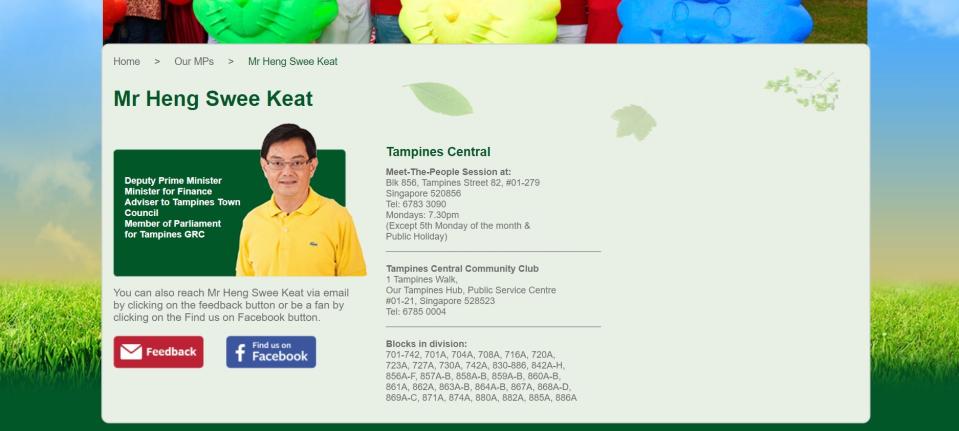
Nothing like a badly cropped photo with a low pixel count that says “I may be the Deputy Prime Minister, but I’m just like you”.
3) Nee Soon Town Council
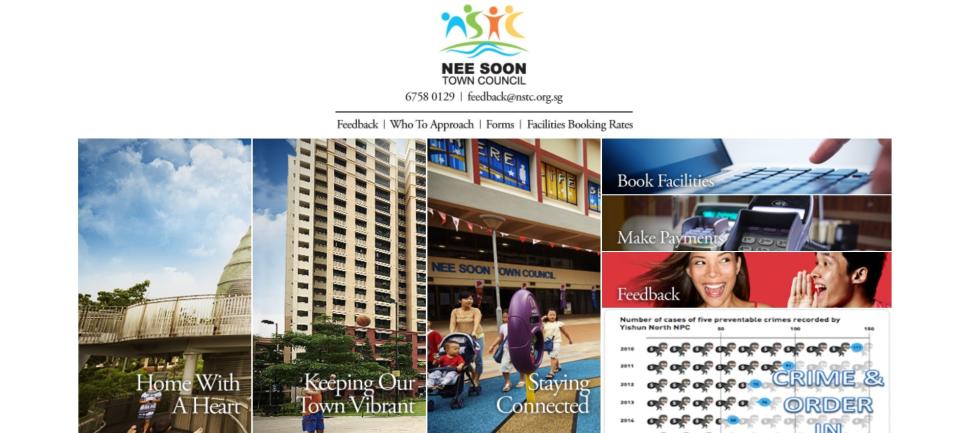
It took us a minute to realise the three photographs captioned “Home With A Heart”, “Keeping Our Town Vibrant” and “Staying Connected” could be clicked and were how you accessed the menu. Clicking the first option, for example, brings up links to learn more about the constituency and the MPs.

Nee Soon has a scrolling slideshow of nostalgic old-school campaign posters linking users to featured articles about its MPs and other township news. It’s a pity, and rather baffling that clicking on the same image on different occasions leads you to a different article each time.
2) Sembawang Town Council
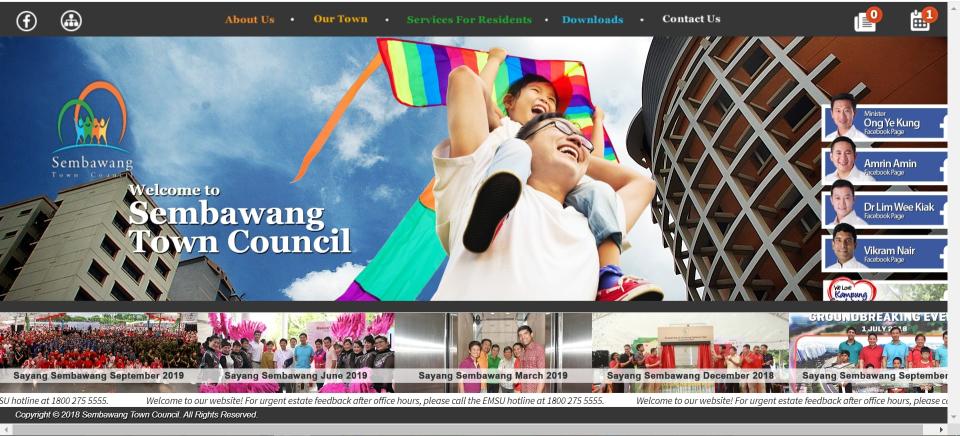

While Ang Mo Kio chose not to utilise the full width of the screen, Sembawang went the opposite route, boasting a website wider than the standard width of a computer screen. This results in the most unnecessary horizontal scroll bar in the history of scroll bars: one that moves barely one centimetre to basically reveal no new information.
Adding to the clutter of the site is a news ticker at the bottom that tells residents they can call an after-hours hotline if they need urgent maintenance. Yes, a ticker.
“Our menu buttons will be in orange, yellow, green and blue, representing the four colours of our logo.” A similar sentence was probably uttered in an earlier design meeting, and conceptually, it may not sound like a bad idea. In reality, though, it’s just plain ugly.
1) Bishan Toa-Payoh Town Council
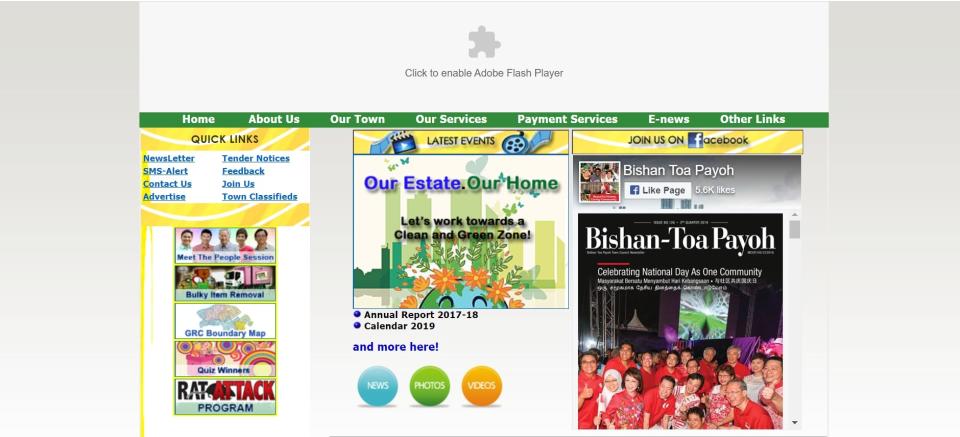

Our grand prize goes to Bishan Toa-Payoh, which — to be fair — does not employ the services of an external company to manage the town council’s operations and might not have the same technical expertise of running a website as the majority of town councils that engage a managing agent.
From the loud colour scheme to three-dimensional fonts to heavily pixelated images, Bishan Toa-Payoh’s website has all the markings of an early-2000s’ site, a la Miniclip or Neopets.
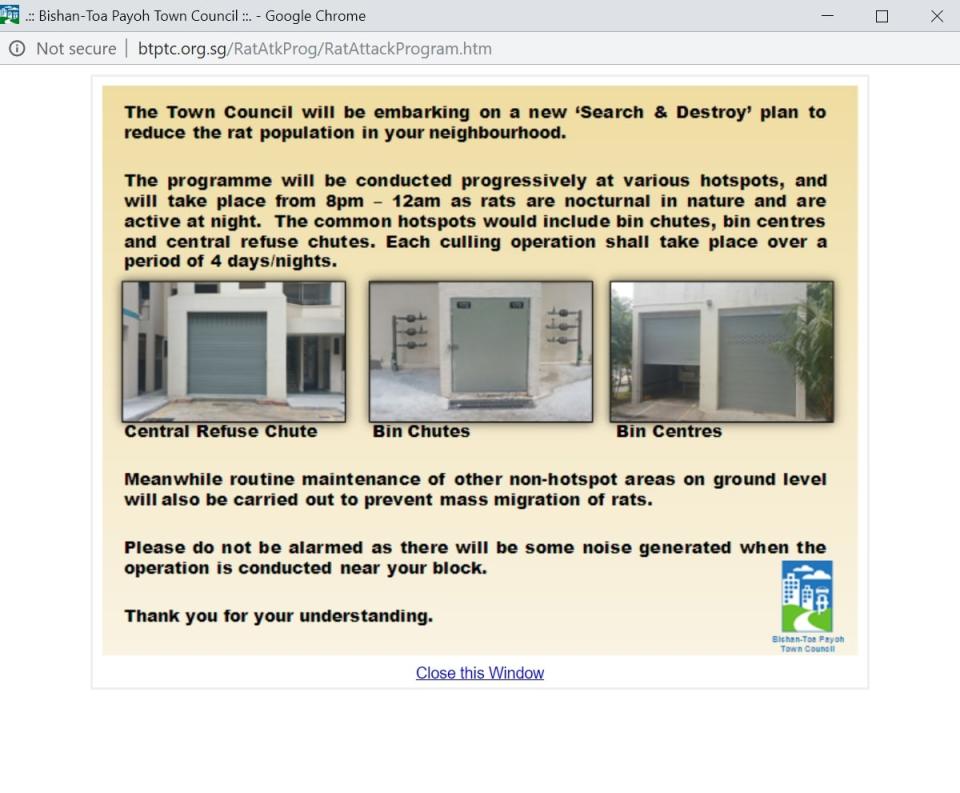
But unlike the since revamped Miniclip and Neopets, pop-ups have not gone out of style for Bishan Toa-Payoh.
Why can’t all Town Council websites be like Chua Chu Kang’s?
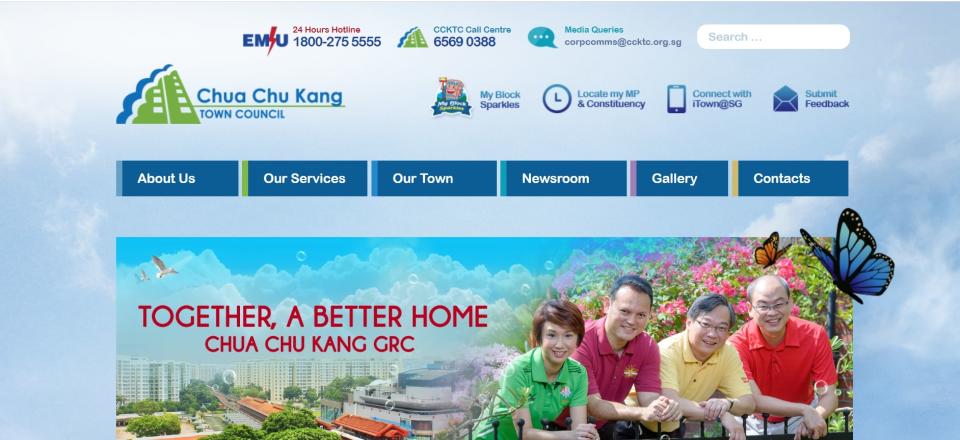
It was a tough call between East Coast-Fengshan and Chua Chu Kang, but we decided to pick the latter chaired by MP Low Yen Ling, for its cohesive colour scheme and user-friendliness.
Sure, Chua Chua Kang shares a fondness for clear skies and butterflies, but as a design choice, it was relatively inoffensive.

The menu was clear which made navigation easy.
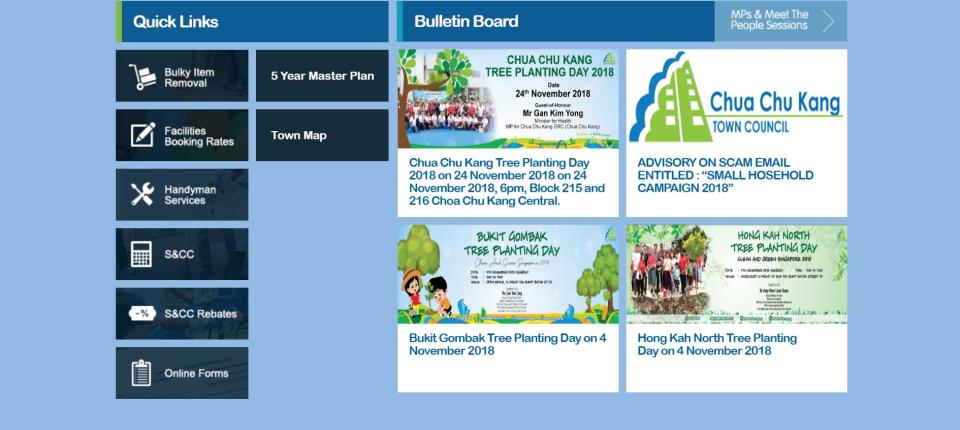
We liked the Quick Links feature which allows residents to quickly access S&CC rates, facilities booking rates and handyman services. We also liked that Chua Chu Kang went with a static bulletin board instead of a clumsy animated slideshow of upcoming events, even though the events listed were outdated.
The council’s contact was always conveniently placed at the top of the website, along with their email for media queries, suggesting a forthcomingness in connecting with its residents and the public.
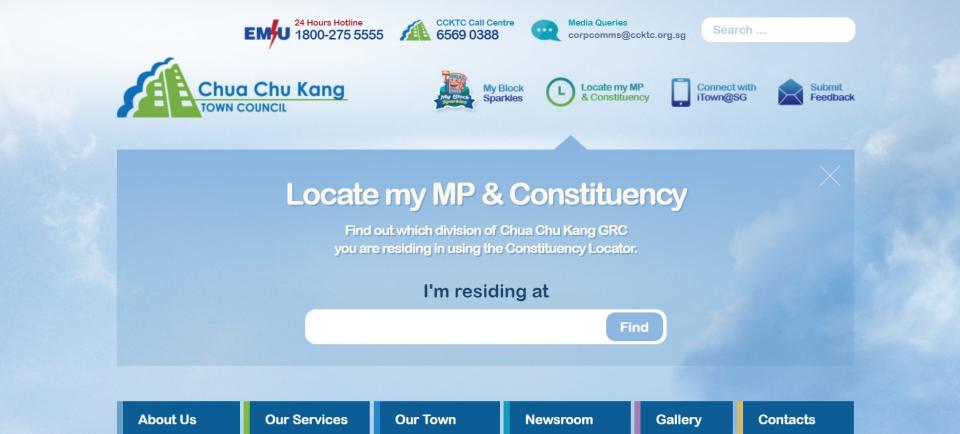
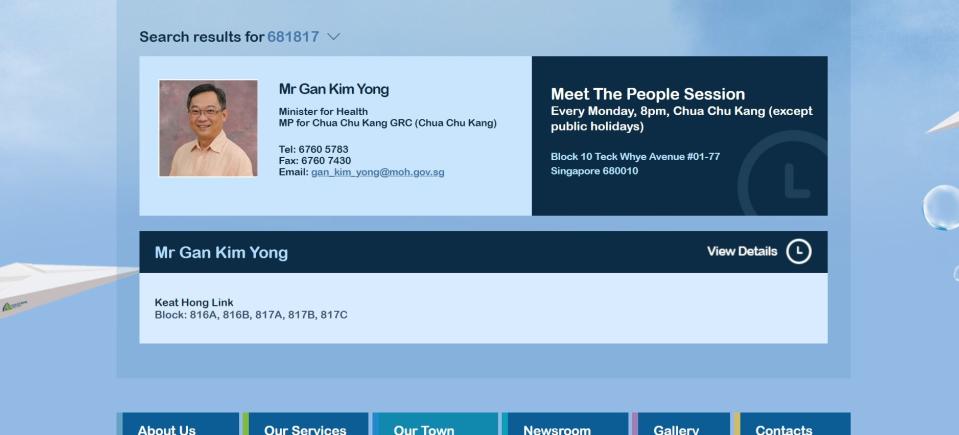
We especially liked the feedback and “Locate my MP & Constituency” widgets in the header which were, crucially, working. Keying in your postal code shows you who your MP is and which division of Chua Chu Kang GRC you belong to — a level of tech-savviness that has escaped Bishan-Toa Payoh.
If you’ve made it this far, you may be wondering if this article was an exercise in frivolity. We thought the same when our editor first gave this assignment to us.
Politics, after all, brings to mind men in suits and women with short hair proposing policies, having intellectual debates and making stuffy speeches in Parliament. MPs aren’t just town managers. They represent our voices on wider national issues in Parliament.
Before town councils were introduced in 1989, HDB functioned as the municipal government looking after the interests of the towns.
“What prompted me and the others to come up with the idea of Town Councils was that we did not quite like the uniformity of decisions taken by HDB,” said then Senior Minister Goh Chok Tong in an interview with the Straits Times in 2009. “Uniformity meant slowness in the implementation of new ideas. As an MP, I experienced that.”
“So Town Councils would give us that flexibility to do different things for our housing estates,” he added. “The political part came in because we tied this in with the elected representatives. So, the MPs would provide the chairman. The MPs would be responsible.”
“This is to give a stake, first, to the MPs, then next to the grassroots leaders, and of course, very importantly, to the residents. This is your Town Council. This is your estate. You have to do something to keep your estate clean.”
Political researchers have argued that the formation of town councils was politically motivated to thwart opposition growth and entrench the ruling PAP in Government. But whether or not the motivation was political, the issue of town council management was often brought up in election campaigns by politicians to bring down their opponents or showcase their own achievements.
The argument goes: how well you manage your town council shows, by proxy, how well you will be able to manage the country. Judging town councils, then, becomes fair game.
While the superficial analysis of town council websites was all in good fun, for the new generation of first-time voters, the online extensions of town councils could be their first contact with the municipal bodies.
And broken links, outdated schedules and pixelated images - while amusing - might not make great first impressions.
Christalle and Daryl are final-year NUS Communications and New Media Department undergraduates.
Related stories
Parliament: Record number of motions filed by MPs
Parliament Q&A: Facts and figures can be touchy subjects too
Which MPs have asked the most questions in Parliament?
And the minister most often up on his own two feet was....


